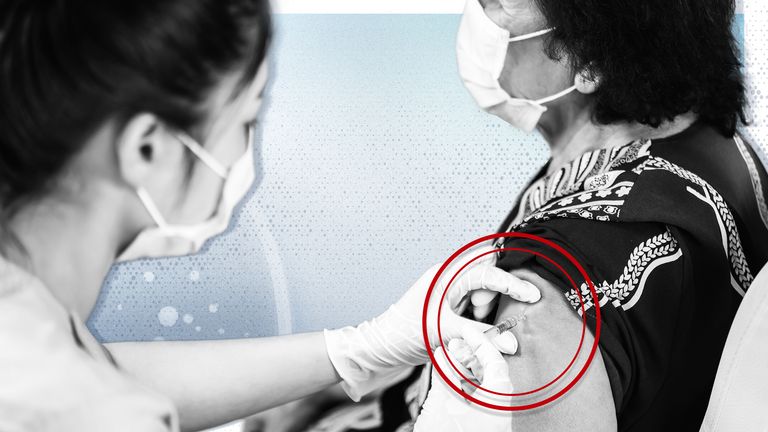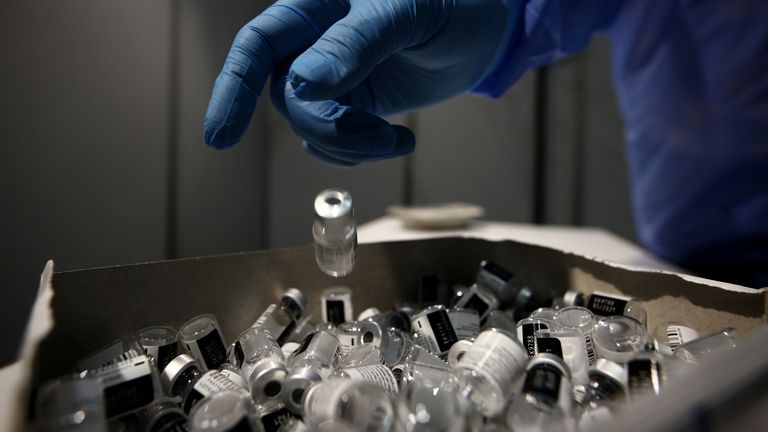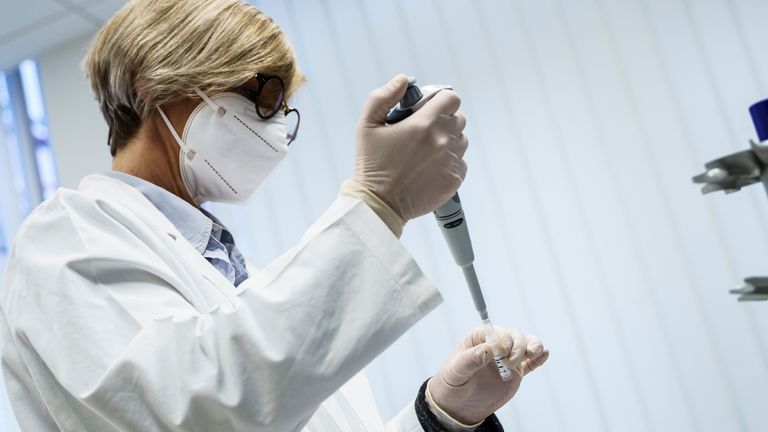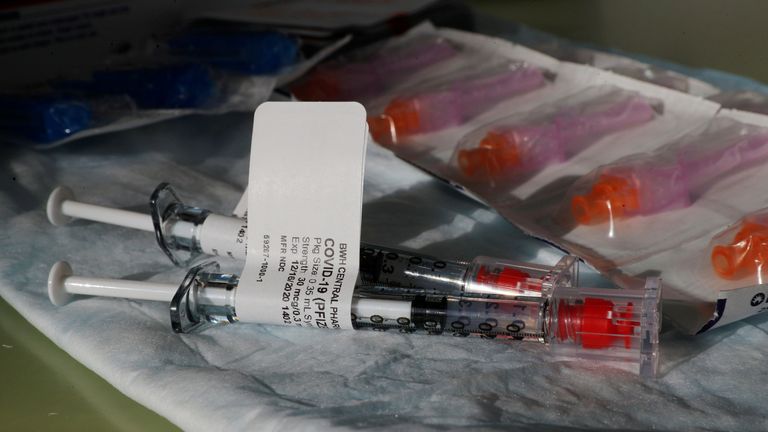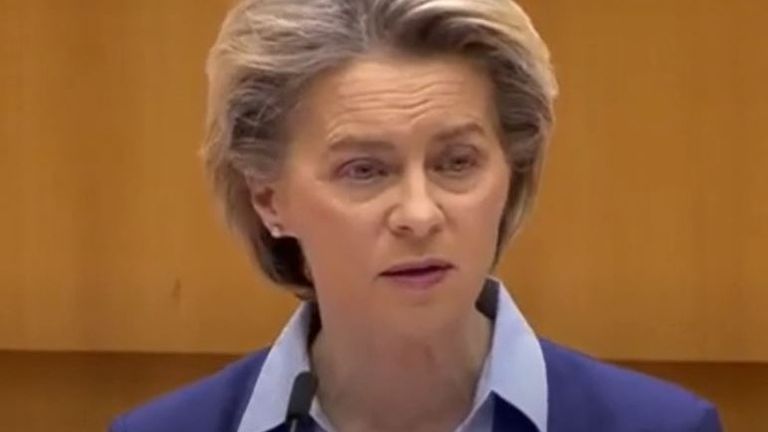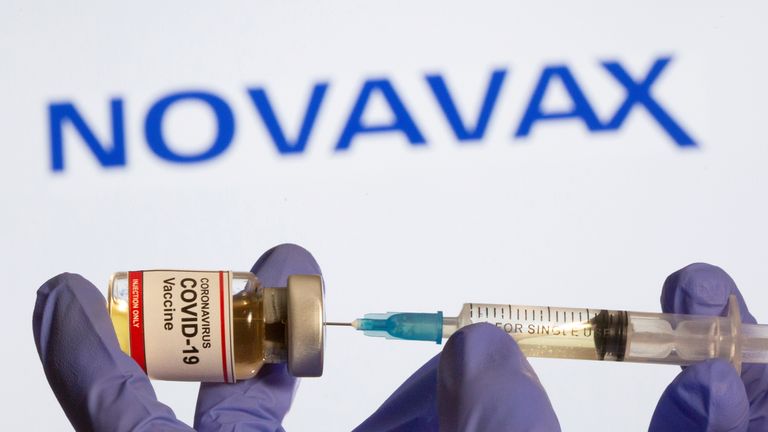COVID-19: A rare and resounding success - how the UK's great vaccine gamble paid off
Monday 15 February 2021 07:44, UK
After a desperate, deadly year of coronavirus, the UK's vaccination programme has delivered first doses to 15 million of the oldest and most vulnerable. It has been a rare and resounding success.
Judged domestically, against the shortcomings of PPE procurement and Test & Trace, or globally, where comparable countries look longingly at the UK's daily dose count, it has been exceptional.
Britain is on course to be the first major economy to inoculate its entire adult population. The rapid emergence of new variants means the benefits can't yet be banked, but they will be counted in saved lives and restored livelihoods.
The vaccine program has also partly revived the state's reputation, battered by failures that have left the UK with one of the highest death tolls and deepest recessions in the world, and a generational crisis in education.
The success has its roots in the chaotic spring of 2020 when - even as the virus threatened to overwhelm the health service - academics, industry, manufacturers, regulators, ministers, civil servants and public health officials were already working on the path out of the pandemic.
Together they committed to spend billions of pounds on vaccines before they knew if they would work, a great vaccine gamble that today has come off.
The race for a vaccine
Vaccines always offered the best path out of the pandemic but nothing was guaranteed. There is still no vaccine for SARS-CoV-1 - which was responsible for the 2002 SARS outbreak - and none had ever been developed for any condition in the timescale this crisis demanded.
Progress in immunology is measured in years, not months, but the pandemic had a galvanising impact, bringing the full resources of national government to bear behind the groundbreaking work of scientists in academic and private sector labs.
When news of a cluster of "pneumonias" in China broke in early January last year, researchers around the world took note. When the genetic sequence of SARS-CoV-2 was published later that month, they began work.
In Gaithersburg, Maryland, Dr Gregory Glenn, head of research and development at Novavax, a small US biotech company, was among them. He was immersed in a phase III trial for a flu vaccine, work considered crucial to the company's long-term prospects, but the coronavirus got his attention.
"I remember it was 9 January and my head of discovery came in and said, 'You know there's a little cluster of pneumonias that have popped up in China'," Dr Glenn told Sky News.
Subscribe to the Daily podcast on Apple Podcasts, Google Podcasts, Spotify, Spreaker
"So I said to him, well, let's find out what it is and maybe we'll go ahead and make one [a vaccine] at the discovery level. Because we have smart people, it's relatively easy.
"I saw him the next day he said, 'I was on the internet and they released the [genetic] sequence, and it's a coronavirus'. So we both agree that's worrisome, because SARS was so bad, even though it was contained it was pretty close to exploding. But there was a very obviously a bad infection, a bad virus and there's no immunity."
Armed with the genetic sequence, Dr Glenn's team set about adapting their existing recombinant DNA technology to tackle the new enemy.
Novavax's vaccine uses moth cells to grow genetically modified coronavirus spike proteins. These are then combined into nanoparticles and primed with extract of soap bark tree, which acts as an adjuvant, improving the immune response.
The aim is to prompt the body to produce antibodies to the coronavirus spike protein, priming the system to prevent the virus taking hold.
And it worked, spectacularly. By April Dr Glenn had the results of animal trials on mice and baboons. "It became very evident that this one we're working on now was the winner."
At which point governments and agencies around the world got very interested, among them a small British team of industry experts empowered with finding a way out.
The vaccine task force
Developing medicines is an industrial process as well as a scientific endeavour, and the private sector plays a central role in the journey from laboratory to patients.
While academia can provide the space and funding to develop breakthroughs, institutions do not always have the capacity to run large-scale clinical trials, liaise with regulators, and even less to manufacture billions of doses from a standing start.
To senior figures in the British biotechnology industry it was clear that for any vaccine to be developed at speed and scale they would have to be involved.
Steve Bates, chief executive of the Bioindustry Association and a founding member of the Vaccines Task Force (VTF), was among them.
"No vaccine had ever been developed successfully for human coronavirus before, but we knew that there were new technologies that have been pioneered that showed some promise," he says.
"And as we were really thinking this through last February, some of the first conversations were, if this works, how could we scale it up, where can we get things made? They were thinking very early on about the industrialization of this, we were there to help."
Those informal conversations led to discussions with the chief scientific advisor, Sir Patrick Vallance, who in April, with Boris Johnson's backing, formalised the task force under the leadership of Kate Bingham, a biochemist, venture capitalist and an Oxford University contemporary of the prime minister.
Formally based in the Department of Business, Environment and Industrial Strategy, the VTF combined industry expertise with senior civil servants but its approach owed far more to the City than Whitehall.
Crucially Bingham had Johnson's ear and the ability to spend public money at risk like an investor, giving the VTF the ability to act fast and gain a competitive advantage.
"With the prime minister putting Kate Bingham in charge and telling her to make stuff happen at a pace, that really cut through," Mr Bates said.
"Supported by excellent civil servants who came from many traditions that had little to do with life science, we were able to give them that insight and make them manage the process really speedily and really effectively in a way that perhaps hasn't been the hallmark of aspects of government."
The gamble
By late spring 2020 there could be no doubt about the severity of coronavirus as the pandemic ravaged the elderly and vulnerable across Europe and the Americas, but there were also grounds for optimism.
Several candidates were showing promise and there was a glimmer of optimism that a vaccine might emerge from the more than 100 projects underway around the world.
For Bingham and her team the question was which ones to back?
Using their experience and contacts the VTF prepared a shortlist of 23, narrowing that down to seven with which they would pursue deals; Pfizer-BioNTech, Oxford-AstraZeneca, Moderna, Novavax, Janssen, Valneva and GSK-Sanofi.
Earlier this month an eighth was added, CureVac, a German company partnered with GSK targeting new variants.
In total the UK has ordered 457m doses at an estimated cost for contracts and development of more than £3bn, with most of those deals done before they knew if the vaccines would work.
Remarkably, six of the initial seven have proven efficacy, with only GSK-Sanofi not yet passing phase 2 trials. Five have proven efficacy in phase 3 human trials - only Valneva is still waiting to report - three have been approved for use and two, Pfizer-BioNTech and Oxford-AstraZeneca, have been administered to more than 15m people.
Even the experts were surprised.
"I'm amazed," says Steve Bates. "I genuinely thought that there was a decent chance that we'd be talking at this stage about why we'd spent lots and lots of money on things that didn't stand an earth of making any difference whatsoever.
"We were betting on this before we knew that the clinical outcomes were strong. In some senses that's a nonsensical approach, but we did it because we knew that vital need for speed."
Pfizer wins the race
The Pfizer-BioNTech vaccine deploys groundbreaking messenger RNA technology, carrying a genetic message that instructs the body to create the coronavirus spike protein. That prompts an immune response, priming the system should the virus itself be encountered.
It was new technology and had complexities, not least the likelihood it would have to be stored at below -70C, but the VTF thought it might be the first to deliver.
The European Commission was also speculating on its success and in June agreed a $100m debt financing deal to boost BioNTech's manufacturing capability, but it did not agree a contract.
By July the UK had done a deal for 30m doses that included indemnifying Pfizer against something going wrong, effectively shouldering the risk.
When the MHRA declared emergency authorisation for the jab in early December the UK was clear to become the first country to administer it outside a trial.
Ben Osborn, country manager, Pfizer UK, says: "This was an unprecedented pace of development with risk being taken by all companies, academic institutions, and governments.
"It's been defined by speed, agility and rapid decision making," he said. "So no lengthy bureaucratic processes in any organisation, on our part, or the government, the NHS or the regulator. It has all been about speed, without ever compromising safety."
"It's been unprecedented and I genuinely hope that we can pull out the learnings from this period, and say, What if we now apply that to cancer, or Alzheimer's, or these other debilitating conditions that we live with today."
Oxford-AstraZeneca, the 'donkeywork' dose
At the Jenner Institute at Oxford University, a team led by Dr Sarah Gilbert believed they could adapt adenovirus technology to counter COVID. Using a neutralised chimpanzee virus as a vehicle, it carries a genetic copy of the coronavirus spike protein into the body, triggering an immune response that primes the system to combat the real thing.
Convinced of its promise as an affordable, practical mass vaccine - it can be stored in a fridge and costs around £3 a dose - by May the VTF had directed almost £90m to the project.
But manufacturing was a challenge, so the VTF introduced Oxford Biomedica, a small company operating from an industrial park beyond the city's ring road.
The government also spent an estimated £42m on exclusive access for two years to a "fill and finish" production line in Wrexham owned by Indian firm Wockhardt, where doses are bottled.
The structure of a deal with a major pharmaceutical partner was also complex. Dr Gilbert had a profoundly philanthropic demand; that the dose be delivered at-cost in the developing world in perpetuity.
The Jenner team had already spun out the rights to its adenovirus technology into a private vehicle intended to capitalise on academic innovation, and advanced discussions had taken place with US giant Merck.
With concerns over its commitment to the at-cost pledge, and ministerial unease that a Trump-led US administration might hoard the product, the Merck deal was unstitched and an agreement reached with AstraZeneca.
The Anglo-Swedish company has no real track record in vaccines but crucially was willing to meet Dr Gilbert's demand. In June the UK ordered 100m doses, still uncertain if it worked.
In late November Oxford reported efficacy of more than 60% in the phase 3 trials, and a month later the MHRA confirmed authorisation. Britain had the dose that would do the donkey work.
The American outsider
When Dr Gregory Glenn's confidence in the Novavax candidate was confirmed by animal trial results last April the response was dramatic.
CEPI, the Coalition for Epidemic Preparedness Innovations backed by the Gates Foundation, made an investment, followed by the US government's 'Operation Warp Speed', which pumped a remarkable $1.6bn into the project, the largest single investment in any single vaccine.
The UK was hard on their heels, demonstrating a willingness to be flexible and support every aspect of development, from clinical trials to manufacturing, to help get it to market.
In August it agreed an order for 60m doses and brokered a production deal with Fuji to manufacture it in Stockton-on-Tees, where in time up to 180m doses a year could be made. In September, Novavax initiated a UK clinical trial which last month reported 89.3% efficacy against the original virus.
Dr Glenn explains how it happened: "This is how it works. One Sunday morning I get a call from Clive Dix [then VTF deputy chairman] on my cell phone. I knew him from long past, and he said, 'we've seen your animal data, we're really interested in your technology, would you consider working with us in the UK'?
"That would be with manufacturing, using our clinical trial network, which I knew was very good, and maybe we'll fund this activity. So the answer is yes, yes, yes. And that's been a fantastic collaboration. They have provided funds, they provided expertise, they provided a window into the regulators, the MHRA.
"We've had very agile, frequent conversations with regulators there and so where we're at today is this trial that we unblinded in the UK is the basis for granting the license, or authorisation in the first place.
"It's the proof, if you will, that the vaccine works. It's been really enabling to work with the UK and they like our technology so I think this has been a grand success."
The regulators
Regulation is crucial to public confidence in medicines, never more so than when a product has been produced as rapidly as the coronavirus vaccines amid a climate of some scepticism.
Typically they proceed cautiously, guided by process and overwhelmingly by safety, but the crisis has seen even these organisations bend to work faster.
In the UK the MHRA agreed to companies running trial phases in parallel rather than waiting for one to end before another can begin. And crucially for the UK's ability to make a fast start on distribution of vaccines, the MHRA issued emergency authorisation for Pfizer and then AstraZeneca, enabling them to be administered batch-by-batch while the companies and the regulator worked through full authorisation.
It insists safety has at no stage been compromised and there is no evidence to the contrary.
A second group, the Joint Committee on Vaccinations and Immunology (JCVI), has also been crucial in getting jabs into arms.
It drew up the list of which groups should be prioritised for injections that has guided the program, with the over-70s, the extremely clinically vulnerable, NHS and care home staff and residents in the first wave of 15m doses.
Usually they wait for the full clinical data to start work, but not this time, says JVCI member Professor Jeremy Brown of Imperial College.
"A lot of that groundwork was done well before we had the data on the Pfizer vaccine showing efficacy, whereas normally it's the other way around, you get the data on the efficacy of the vaccine and then you work out how to use it."
The JCVI also made a second crucial decision that has had a profound practical impact on the pace of distribution. In early January it advised that the three-week gap between doses for both the Pfizer and AstraZeneca vaccines be extended to 12 weeks.
"Most of the protection against infection is achieved by one dose, and that opens up the possibility that instead of vaccinating one person twice, you can vaccinate twice as many in a short period of time and still have still have most of the protection," Prof Brown said.
"It seems a fairly obvious equation that if you've a vaccine that has 80% efficacy with one dose, then you give that to as many people as possible rather than give 85% efficacy to half the number of people, which is what would happen if you give two doses within three or four weeks."
At a stroke it transformed prospects for distribution, effectively giving the NHS three months to reach as many people with first doses as it could before the second dose "debt" has to be met.
The NHS delivers
The benefits of a truly national health service have never been more apparent. The unique mix of hospital trusts, community health teams and GPs that fall under the NHS banner might have been designed for dosing every adult in the country, starting with the most vulnerable.
In large part they were. NHS local managers have spent much of the last decade wrestling with how to better coordinate regional and local services over and around the internal barriers imposed by the 2012 Health & Social Care Act.
Primary care networks that link GP practices have been invaluable, providing the blueprint for distribution as practices combined in local centres to vaccinate their lists of patients.
These networks enabled the NHS to stand up more than 700 vaccination centres for mass vaccination in early January, adding several hundred more by the middle of the month. Add community pharmacists and there are more than 1,500 currently operating.
The contrast with the consultant-led fiasco of Test & Trace, a multi-billion pound outsourcing failure that has missed target after target, could not be clearer.
Community centres, sports grounds, even fire stations have been transformed into vaccination hubs, with many GP-led centres matching much-vaunted "mass vaccination centres" shot-for-shot.
Supply, the crucial factor, has been closely monitored to ensure that the network has the doses it needs to meet demand, with ministers calling executives direct to smooth out any issues.
In Gloucestershire, more than 98% of over-80s were injected by the first week of February, the best rate in England, and at Cheltenham Community Vaccination Centre in the city's fire station you can see why.
It is staffed by nurses and GPs working a single extra shift a week each, plus volunteers to marshal and ensure COVID-safety, and runs on experience and goodwill.
Having comfortably met the first target of vaccinating the top four priority groups, its now onto groups five and six, aged 65-69 and the clinically vulnerable.
"We had around two weeks to get everything set up and going at this site when we knew that the vaccine was going to be approved. So, it was quite, quite short notice and a big, a big effort at the start to try and get everything up and up and running," says Dr Cameron Jackson, the PCN lead.
"We've got 16 practices across three primary care networks that work and vaccinate from this centre and around 135,000 patients, and we've vaccinated all the top-priority cohorts across those patients."
Nurse practitioner Sarah Gallagher, the clinical lead for the centre, explains how they have become so fast.
"We do 120 patients an hour in six pods and we're working 12 hours a day. So as long as the vaccine supply is there, we can vaccinate 7,000 people a week. If we get more supply we can just open more pods. It's exhausting but worth it.
"We've got more and more efficient as it has gone on. Now the patients are getting a little younger we vaccinate them standing up if possible, to save time on cleaning chairs, which we have to do if they sit down. And all the teams are competing to see who can do the most every day. It's always a nurse that wins!
"It's the most humbling experience any of us have ever had. Because we're making such a difference to people's lives."

